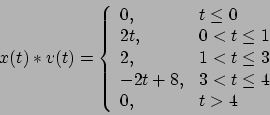EE 341
Homework Assignment 6
Due Oct. 6, 2004
- Problem 3.26. Note: This problem is easy if you use the properties of
convolution on Pages 124 and 125.
- Problem 3.30 (a) (b) (e). Here is the solution to
Part (c)
Note: The exact solutions to (a), (b), and (e) are:
(a)

(b)

(e)

- Problem 4.1. You may use a calculator or MATLAB for this problem.
- Problem 4.2. You may use a calculator or MATLAB for this problem.
- Problem 4.3.
- Problem 4.5. Note: For figure (ii), the amplitude should be 1, and the
width should be a, so the pulse should go from -a/2 to a/2.
Bill Rison,
<rison@nmt.edu >





